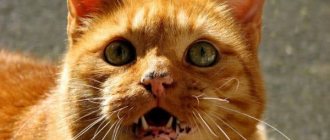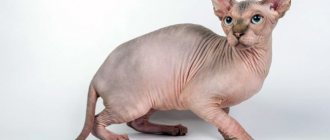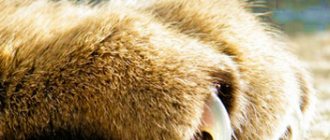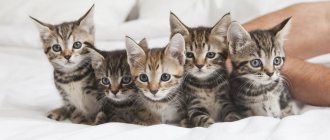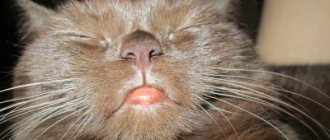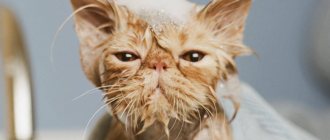Blackheads in cats can appear for various reasons. They are found in different parts of the pet's body. Getting rid of the problem at an early stage is much easier than subsequently treating serious complications caused by inflammation. Treatment includes creams and ointments, as well as special diets.
At-risk groups
Veterinarians believe that the appearance of acne is not related to the breed, age or gender of the pet. Pathologies can be either isolated or regular, cyclical, depending on the cause of the disease.
Statistics show that castrated and sterilized animals are less susceptible to the disease, but even in this case its occurrence is not excluded.
Most often, acne appears repeatedly in cats, so it is important to completely cure the animal the first time acne appears.
In individuals with long hair, lesions may appear on the face and in the folds of the skin. The only exception is hairless cats (Sphynxes), due to greater sebum secretion than other breeds, these animals have a higher risk of acne. Careful care helps eliminate the risk of pathology.
Causes of rashes depending on location
Your cat has worms: how to treat them at home
According to experts, one of the most common causes of blackheads in cats is pollution. But at the same time, this condition can be a consequence of other reasons.
Black spots on the lower jaw
Dark-colored sores can appear on the lower jaw in cats due to hereditary predisposition. In this case, you can ensure the normal condition of the skin with the help of properly selected hygiene products.
Black dots on a cat's lower jaw
On the lips
Having noticed black spots on a cat's lips, every owner should be wary. This manifestation may indicate the development of fungal diseases. At the first signs, it is important to immediately seek qualified help, since it is impossible to independently determine the type of infection.
Acne on a cat's lips
In the mouth
Sometimes attentive and caring owners may discover that black spots have appeared in the cat’s mouth. Basically, such a deviation indicates natural processes that do not pose a threat to the health and life of the pet. But still, in rare cases, this may indicate the development of pathology.
Important! Black spots in the mouth can appear as a result of normal pigmentation, allergic reactions, stress, dirty dishes, poor environmental conditions, and oncology.
Treatment with home remedies
In the mild, initial stages of the disease, the problem can be dealt with using home and folk remedies. Do not forget that acne treatment must be agreed upon with a veterinarian.
Sometimes treating blackheads with a two-phase makeup remover helps. By carefully blotting with a cotton swab moistened with the product, excess sebum and dirt are removed from the affected areas, and the skin is disinfected.
It is important to remember that this method can only be used in the absence of ulcers and inflammation.
If the nature of the disease is allergic, then changing the food or replacing plastic dishes with metal and earthenware usually helps.
If there are no ulcers, inflammations, or infected wounds, the use of folk remedies is acceptable. For example, lubricate acne with a mixture of two Furacilin tablets and chamomile decoction or fresh pumpkin juice. If there are a small number of blackheads and no pustules, lotions made from celandine infusion or yarrow decoction can also help.
Traditional treatment scheme
Veterinarians claim that with proper treatment of isolated cases of acne, a complete recovery of the animal is possible without relapses.
If comedones reappear, the cat will most likely need lifelong treatment and daily hygiene procedures.
When the disease is in an advanced stage, bloody scratches form in place of the blackheads and a secondary infection occurs - a fungal or bacterial infection of the skin. Timely contact with a veterinarian and comprehensive therapy will help prevent the disease from developing serious complications.
In complex treatment, the following drugs and procedures are prescribed:
- Antiseborrheic shampoos such as Lactaderm and Doctor. They contain sulfur, salicylic acid, benzoyl peroxide, ethyl lactate, which help remove fat and dirt and have a drying effect. Wash the animal once or twice a week.
- Products with local cleansing and antiseptic effects. This could be Chlorhexedine, Furacilin solution, Miramistin, hydrogen peroxide. In addition to disinfection, these drugs help relieve itching.
- Brilliant green or iodine - applied to the affected area after antiseptic treatment, dried and disinfected comedones.
- Ointments and gels with anti-inflammatory and drying effects - Flucinar, Levomekol, Tetracycline, Leniment synthomycin, syntomycin and zinc.
- Antibacterial ointments or gels, such as Mupirocin, Flemoxin salutab or Bactroban.
- Combined preparations in the form of ointments with benzoyl peroxide and antibiotic (Baziron, Zinerit).
- Retinoid ointments with vitamin A (Differin, Adacoin) have an immunomodulatory and anti-inflammatory effect, preventing follicle blockage.
- Systemic antibiotics are prescribed only in difficult cases - when blackheads turn into ulcers, follicles and infected wounds. 90 percent of acne diseases are cured without antibacterial injections. Amoxicillin, Enrofloxacin, and cephalosporins are usually prescribed.
Fungus on a cat's chin is a serious danger for your pet.
It is always a good idea to take a closer look at the condition of your furry pet. The slightest changes in his behavior and/or appearance are the most important indicators that can indicate in advance the development of dangerous pathologies.
For example, small bald patches on a cat's face could be a sign of poor nutrition... or something more serious. For example, a fungus appears on a cat’s chin, some pathogens of which pose a serious danger to the life and health of your pet.
It is believed that strange bald patches on the chin may be a sign of ringworm (ringworm). This is a common group of fungal skin diseases that practicing veterinarians encounter very often.
Most pathogens of mycoses (for example, the Trichophyton fungus) have very high virulence, causing disease even in animals with a relatively normal immune system. Moreover, lichens are extremely dangerous because they are not species specific.
But! Note that, regardless of the cause (i.e., the specific type of pathogen), the development of the disease is greatly facilitated by poor feeding, stress and allergies. These factors adversely affect the state of the animal's immune system.
Despite the presence of relatively specific symptoms, diagnosing dermatomycosis can be very difficult, sometimes dragging on for several weeks (the pathogen grows very slowly on nutrient media). The sooner the owner notices that something is wrong with his pet, the greater the chance of quickly treating the cat and avoiding infection himself.
Despite the increased virulence of many mycoses, an important role in infection/non-infection is played by the physiological state of the animal, its nutritional characteristics, and the presence or absence of strong stress factors.
The main route of transmission is direct contact between a healthy animal and a sick animal. In such cases, the infection rate exceeds 70% (i.e., if you come into contact with a sick cat, your pet has a 70% chance of becoming infected). In addition, fungal spores can end up on bedding, toys, brushes, clothing, gloves of owners, or even on fleas.
Accordingly, the development of the disease is greatly facilitated by cramped living conditions. It is not surprising that in many cat shelters the infection rate of animals can quickly reach 100%. Despite this, the question still remains about the likelihood of infection after a single contact of a cat with contaminated care items.
But here, most likely, the main role is played by the number of transmitted spores. So, there probably won’t be a lot of them left on the scissors, but on the comb there will be plenty of “seeds” of the pathogen. The same goes for litter and cat baskets. You should only select new ones for your pet, or purchase them only from owners of guaranteed healthy animals.
Since primary symptoms often go unnoticed, in practice we often have to deal with already complicated (secondary bacterial infections) lichens. Alas, in such situations, animals not only have bald patches on the chin and other parts of the body: everything is much more serious.
Extensive foci of inflammation and scabs appear on the skin, and abundant exudate is visible from the ulcerated areas. The remaining fur becomes matted and turns into “icicles”, being glued together by the exudate. It is possible to develop infections of the upper respiratory tract and oral cavity (also fungal or secondary bacterial).
Diagnostics
The most accurate method, which makes it possible to make a diagnosis with 100% probability, is growing a culture of the pathogen on a special nutrient medium, followed by microscopy.
The problem is that fungi take a very long time to grow. Therefore, for “emergency” diagnostics, the so-called Wood’s lamp is often used. The idea is that some strains of dermatomycetes begin to fluoresce under UV radiation.
True, this method does not always work.
In addition, the diagnosis is made on the basis of data obtained from conventional microscopy of hair samples and scrapings from the animal’s skin. In this case, it is highly advisable to tint the samples and conduct the study using oil lenses. In this case, the image in the field of view is more contrasting, and therefore it is much easier to detect the pathogen.
Treatment
Treatment can only be local.
- Use YaM ointment, sulfur ointment, salicylic acid.
- Enilconazole-based shampoos are recommended.
- If the animal’s condition is severe and there is a suspicion of a concomitant bacterial infection, econazole and clotrimazole are also prescribed in oral form, supplemented with broad-spectrum antibiotics.
It is difficult to treat cats with advanced symptoms; therapy takes much more time than if the owner had only just discovered the first symptoms of infection. But what’s much worse is that in advanced cases, the pet’s immune system suffers greatly, which is why the cat has to be treated for both fungus and infections.
To speed up recovery, it is recommended:
- Wash food and water bowls daily;
- do not feed your cat fatty foods;
- change the water regularly;
- clean your pet's chin after every meal;
- do not comb out the affected area;
- Do not crush acne under any circumstances.
How to care for a sick cat
It is better to shave the fur on the acne-affected area. Areas with blackheads and inflammation should be washed daily with tar soap and special gels. They are applied with a swab, then carefully washed off with a damp cloth and blotted dry.
Sometimes acne is steamed and blockages in the hair follicle are removed. A hot cotton napkin soaked in chamomile decoction is applied to the affected area.
In complex therapy, ointments and gels are used as adjuncts to prevent the formation of ulcers and inflammation and are used until acne completely disappears. They are applied for 30-40 minutes, then the excess is removed with a cotton swab.
Before using them, the skin is cleansed with antiseptic agents.
Sometimes castration helps in the treatment process; after this procedure, hormonal levels decrease and acne may go away on its own.
When using any external therapy (liquid solutions, gels and ointments) to prevent poisoning, you must ensure that the cat does not lick itself.
Squeezing out acne from your pet is strictly prohibited.
If pus spontaneously discharges from burst pimples, it is carefully removed with cotton swabs. When drying crusts form, they are not removed, but wait until they fall off on their own.
Special diet
During treatment, the veterinarian will most often immediately recommend putting the cat on a special diet, eliminating any fatty and high-calorie foods from the diet. This is done in stages:
- Refusal of dry and canned food.
- Introduction of fiber and carbohydrates into the diet, usually in the form of porridges made from oatmeal and pearl barley.
- Adding vegetable or fruit stews and purees to the daily portion of food.
- Addition of vitamin complexes (ascorbic acid, vitamin A, tocopherol). It is important to observe their correct dosage. Excess can cause allergic reactions, and deficiency can cause vitamin deficiency.
Symptoms of acne
The following symptoms are typical for this disease:
- Redness of the skin;
- The appearance of swelling in the area where blackheads accumulate;
- Development of ulcers, hair loss;
If left untreated for a long time, these symptoms often cause anxiety, the pet becomes nervous and irritable, and may show aggression. In addition, the cat begins to scratch the damaged area, thereby increasing the risk of a new infection and deterioration in overall health.
An examination by a specialist and taking a scraping will help rule out the presence of diseases with similar symptoms. These include:
- Diseases of the stomach and liver. Caused by poor diet or complications after an illness. Lead to rashes all over the cat's body.
- Demodecosis. Characterized by the presence of subcutaneous mites. It is characterized by the appearance of ulcers, itching and hair loss. Easily transmitted to other animals.
- Allergy. Common causes are a reaction to food, collar, litter. It is characterized by the appearance of pimples or black spots in the cat’s fur, redness of the skin and itching.
- Lichen. The development is provoked by a fungus, as a result of which peeling and rashes appear on the cat’s skin, which lead to itching and baldness.
In addition to the above reasons, a strong argument indicating the need for examination by a veterinarian is a deterioration in the pet’s general health, refusal to eat, vomiting, lethargy and constant drowsiness. After conducting a visual examination, the doctor will prescribe the necessary examination, which may include various tests - skin scraping, fungal exclusion analysis and biopsy.
Mr. Cat recommends: is there a danger to humans?
With any illness in an animal, there is a danger of infection and fear for the household. But in the case of cat acne, there is no need to worry - this pathology is absolutely safe for people. Caring for a sick animal will not bring any harm to a person.
Acne occurs for a number of reasons; this disease is not viral. Even small children, the elderly and people with a low immune background will never get acne from a sick cat.
Read the article about what a person can actually get infected from a cat.
Reviews from veterinarians about acne
global $ads_google;
//data-ad-slot=”2475549904″ $ads_google = empty($ads_google) ? false : true; ?> if ($ads_google == false) {?> $ads_google = true; ?> } ?> The opinion of representatives of veterinary dermatology is expressed in the advice not to self-medicate, but to visit a specialist: the sick animal must be examined, a scraping taken from the affected area of the skin and a laboratory test performed. This is done in order to exclude the possibility of other diseases, including allergies.
Feline acne is similar in symptoms to dermatophytosis, demodicosis, scabies and eosinophilic granuloma. The analysis will show whether there is reason to worry about the above diseases.
Veterinarians do not consider the disease to be serious and prescribe a qualified treatment regimen, which, if followed, will solve the problem quickly and easily.
Prevention of comedones in cats
Acne is not a serious or dangerous disease, and the cat is not at risk of death. But this pathology is extremely unpleasant and causes a lot of anxiety for both animals and humans. If the appearance of acne is not caused by a genetic predisposition of the pet, its occurrence can be easily prevented by following fairly simple preventive measures:
- Do not use plastic bowls for feeding. It is better to replace them with products made of stainless steel or earthenware.
- It is necessary to ensure the cleanliness of feeding containers. It must be washed before every meal.
- Drinking water should always be clean. It is recommended to change it at least twice a day.
- The food should not remain in the bowl for more than five hours.
- Provide properly selected nutritious nutrition. Don't forget about vitamins and special supplements with Omega-6 and Omega-3 acids.
- Monitor your pet's hygiene. If necessary, wipe his chin after each feeding. This is especially true for the Persian cat. Due to the peculiar structure of her jaw, she practically cannot eat on her own, and always gets very dirty when feeding.
- The cat's skin and fur must be kept clean. Don't forget about timely brushing and bathing. Brushes should be used with soft to medium hardness. Trauma to the skin can easily lead to the formation of acne.
- If the cat is not intended for breeding, it must be neutered in a timely manner. This can prevent the development of pathology.
- Regularly treat your animal for external parasites.
- Monitor the cleanliness of the house, bedding, beds - all places where the pet spends a lot of time.
- Maintain normal temperature and, especially, humidity in the room where the cat is kept.
Main causes of rashes
A cat has diarrhea with blood: what to do and how to treat it
If black specks appear on a cat's chin, then this condition can be caused by numerous factors. Most often, problems arise as a result of the individual characteristics of the animal’s body. To reduce the amount of blackness, you need to carefully care for your pet.
The reasons that provoke this condition also include:
- poor nutrition;
- pathologies of the sebaceous glands;
- hormonal disorders;
- liver diseases;
- decreased immunity.
To determine the cause of the problem, it is recommended to immediately contact a veterinarian at the first sign.
Poor hygiene
The most common problem. As a result of poor quality care, blackheads and dark-colored pimples appear on the cat’s body. This occurs due to the large accumulation of sebaceous glands. Excessive care for your pet can also lead to the development of pathology.
Hormonal disbalance
Both humans and cats can experience hormonal imbalances. As a result of this, several diseases arise. The most common is the appearance of blackheads. The cause of the pathology may be improper behavior of the owner, overfeeding, inappropriate food, as well as improper behavior of the owner and taking hormonal medications.
Infection
Problems with the skin are observed even in cats that do not go outside and are properly cared for by their owners. Cats often develop black acne as a result of infections. As a result, your pet develops painful ulcers.

